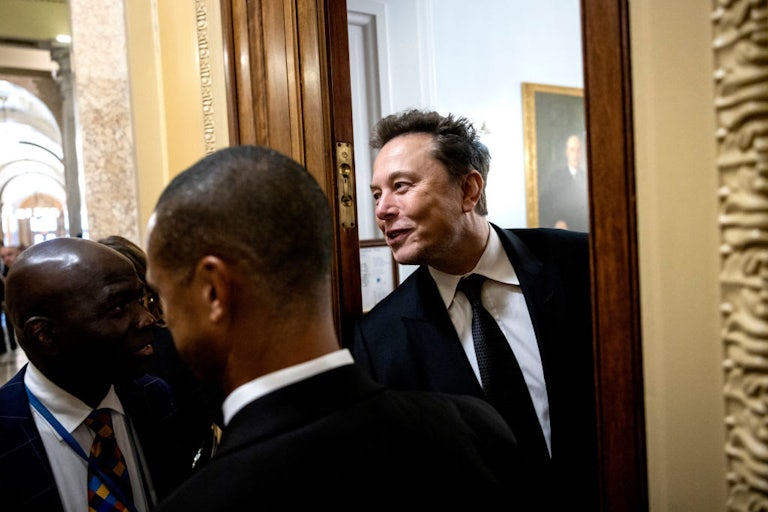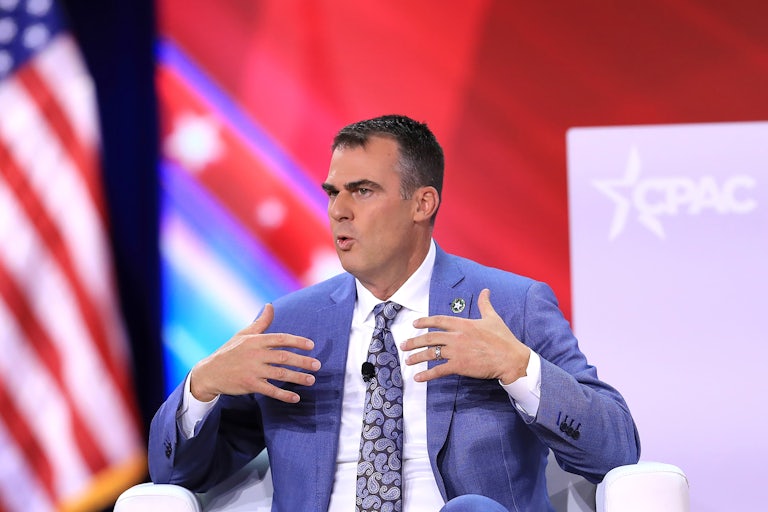How the GOP Became the Party of Pet Slaughter
What is it with Republicans and dog killing?

Heritage Foundation president and Project 2025 architect Kevin Roberts stands accused this week of killing his neighbor’s dog with a shovel circa 2004. Three people who knew Roberts during his time at New Mexico State University told The Guardian that they remember Roberts telling them that he had killed the dog because it was barking too much. Three more people reportedly recall hearing the story at the time from those colleagues. Guardian reporter Stephanie Kirchgaessner also tracked down Roberts’s neighbor, who said that his dog, Loca—he provided a photo—indeed disappeared around 2004, when the neighbor was 16.
Killing a teenage neighbor’s pet out of irritation and then telling co-workers about it might seem like a whole new level of bizarre, even for this already surreal election cycle. Roberts, however, denies it, calling the allegation “patently untrue and baseless.” In some ways, that denial is the most unusual part of this whole story.
Had Roberts confirmed that he killed a dog, he would hardly be the only prominent conservative in recent years to treat such an act as a badge of honor. The most striking example is Kristi Noem, who stunned the country this spring by bragging in her book about shooting her 14-month-old puppy and a family goat, portraying the story as an example of her grit and fortitude. (The dog, apparently, was hard to train and killed some chickens while off leash. The goat was “mean.”) The book was widely seen as an attempt to burnish her credentials for Trump’s V.P. slot. In response to the widespread backlash, Noem dug in, insisting that these were the sorts of tough calls necessitated by country life.
The episode made for lots of late-night satire. But if you cast your memory back a bit further, you can kind of see where Noem got the idea that killing animals and boasting about it was a form of informal right-wing résumé building, akin to knocking back bourbon after work to prove you can hang with the boys.
I’m not talking about Mitt Romney—the strangely ubiquitous comparison made in news coverage of Noem’s book. Romney may have strapped his dog to the roof of his car using a windshield-equipped crate in 1983, but he did not kill his dog, nor did he intend to kill his dog, and he bristled at those comparing him to Noem—which makes sense, because Romney’s conservatism has never been the sort for which animal cruelty functions as an in-group signifier. (If Mitt Romney had killed his dog, it would have seemed incoherent and try-hard, because he’s just not cowboy-coded.)
The better example of this trend would be Montana Governor Greg Gianforte, who has repeatedly incorporated questionably legal violence into his “rugged Westerner” brand. While Gianforte first made headlines for assaulting a human reporter in 2017, he also illegally killed an underage elk in 2000, and then received a written warning in 2021 for trapping and shooting a collared Yellowstone wolf without having taken Montana’s required (and free) wolf-trapping certification course—which covers, among other things, trapping ethics. Trapping critics argue that there is no such thing as humane trapping, given that the trapped animal may suffer for hours or even days. But Gianforte campaigned on the issue, saying that “the effort to stop trapping in Montana is an attack on our heritage.”
Gianforte again made headlines in 2022 when he shot and killed a researcher-monitored mountain lion that hunting dogs had pursued up a tree. This time, the killing was legal, although there was some dispute about whether the dogs had kept the mountain lion up a tree for hours before the governor arrived to shoot it—just as there was some question, with the wolf trapping, about whether the governor had been called from far away to finish off the trapped animal.
Gianforte, whom Trump has called “my guy,” falls into a category of Republican politician that has grown more prominent over the past two decades: the hunter that even other hunters express misgivings about. In 2003, Vice President Dick Cheney participated in a so-called “canned hunt,” shooting pheasants that had been raised in captivity and then released specifically for this event. “I don’t see anything terribly wrong with it, but I don’t think it should be confused with hunting,” Sid Evans of the hunting magazine Field & Stream told The New York Times.
The Republican Party at this point was losing its animal-friendly vibe in general. While Nixon was a staunch conservationist, and George H.W. Bush banned ivory imports to protect African elephants, the younger Bush proposed reversing the ban on importing hunting trophies of endangered species into the U.S., and later named a top lobbyist for the trophy hunting organization Safari Club International as acting director of the U.S. Fish and Wildlife Service. (Bush received the organization’s “Governor of the Year” award in 2000, over the objections of the Humane Society.)
In the 2008 election, vice presidential candidate Sarah Palin’s support for aerial wolf gunning—a practice deliberately designed to give hunters the advantage and thin out wolf numbers—was denounced by animal lovers but lauded by her supporters, who loved her “frontier femme” identity politics. After the 2008 election loss, Palin ritualistically pardoned a Thanksgiving turkey but gave an interview in front of a man decapitating the other birds. The show Sarah Palin’s Alaska routinely featured graphic footage of the governor and her family hunting and gutting animals.
Then, of course, there were the Trump children. In 2011, Donald Trump Jr. and Eric Trump traveled to Zimbabwe with a safari firm that Zimbabwean conservationists later said was not registered in the country. They killed an elephant and leopard, among other animals, posing with the dead bodies. “I AM A HUNTER I don’t hide from that,” Trump Jr. tweeted when the photos surfaced the following year. In late 2019, ProPublica reported that Trump Jr. had received “special treatment” during a trip to Mongolia, shooting an endangered argali sheep, for which he was retroactively given a permit after meeting with Mongolia’s president. (The hunting trip was later reported to have cost American taxpayers over $75,000.)
The Trump administration, incidentally, also oversaw the reversal of policies banning the imports of lion trophies into the U.S., and re-legalized controversial hunting tactics like killing wolf pups and using bait to kill bears and wolves in the Alaska wilderness—mere months after the Safari Club had auctioned off a seven-day Alaskan deer and sea-duck hunt with Trump Jr. as part of its annual convention.
This isn’t a comprehensive list, because the examples are too numerous to recount. In 2022, Trump’s former secretary of the interior, Ryan Zinke, posted a picture of himself pressing a hot cattle brand into a strapped-down calf during his congressional campaign. As Jan Dutkiewicz and Gabriel Rosenberg memorably wrote for The New Republic last year, meat eating is now so entrenched as a masculinity marker on the American right that vegetarian men minding their own business are now mockingly referred to as “soy boys.”
It wasn’t a foregone conclusion that willingness to kill animals would become a kind of right-wing purity test. In the 2012 primaries, noted animal lover Newt Gingrich attacked Mitt Romney over the dog-on-car episode. Gingrich was similarly unimpressed by Noem’s dog-killing story. Yet the Gingrich-like voices are increasingly drowned out by the Noems, or by Ron DeSantis decrying the horrors of meat that hasn’t come specifically from a dead animal.
So maybe Kevin Roberts bragged at work about killing his kid neighbor’s dog with a shovel, or maybe he didn’t. At this point in the history of American conservatism, he’s going to have a tough time convincing people to give him the benefit of the doubt.
Good News/Bad News
![]()
The U.S. is not, contrary to President Biden’s claim at the U.N. on Tuesday, on track to cut emissions by 50 percent by 2030.
Stat of the Week
7/9
Seven of the nine “planetary boundaries” keeping life on earth stable may now have been crossed, according to the Potsdam Institute for Climate Impact Research.
What I’m Reading
In Praise of Climate Virtue Signaling
In recent years, politicians have tried to portray the climate crisis as something that can be solved without major behavioral shifts, worried about sounding preachy or alienating voters. Matt Reynolds at Wired has mixed feelings about that:
I think about this dynamic a lot when it comes to food, and particularly alternatives to beef, which has an outsized carbon footprint compared with almost any other foodstuff. A lot of people hope that making plant-based burgers cheap and tasty will be enough to switch vast numbers of meat-eaters over to the plant-based side. When I hang out at alternative protein conferences, no one wants to talk about the morals of eating meat, although I suspect that is a major motivator for many of the people there. They assume that argument won’t win over any converts to pea protein burgers or whatever.
Maybe they’re right. But I suspect that if we ignore the moral component of climate decisions, we drastically limit the whole scope of our climate ambition. It’s not that morals should make up the whole or even a significant part of our decisionmaking, and we shouldn’t expect people to be morally consistent either. Morality isn’t the whole part of the climate story, but it’s not exactly a footnote either.
Read Matt Reynolds’s full piece at Wired.
This article first appeared in Life in a Warming World, a weekly TNR newsletter authored by deputy editor Heather Souvaine Horn. Sign up here.









